Physical Address
304 North Cardinal St.
Dorchester Center, MA 02124
Congenital heart disease in adults has two basic categories:
The initial clinical presentation of previously undiagnosed and untreated congenital defects
Survival into adulthood of patients with known congenital heart disease and previous surgical procedures
In adult patients with no previous diagnosis of heart disease, a congenital defect often is not considered as a potential cause of symptoms, and thus the initial diagnosis may be made at the echocardiographic examination. In these patients, the diagnostic challenge is to recognize and correctly evaluate the congenital abnormality. In contrast, in patients with known congenital disease and previous surgical procedures, the goals are to identify the postoperative anatomy and assess the physiologic consequences of residual defects in each patient. With “corrective” surgery, as with “palliative” procedures, many patients have significant residual or progressive abnormalities.
Both these challenges can be met by a logical and methodical approach to the echocardiographic examination with the application of the basic principles of ultrasound imaging and Doppler data described throughout this text. In addition to careful integration of imaging and Doppler data, evaluation with other imaging modalities, such as cardiac magnetic resonance (CMR) imaging or computed tomography (CT), often is needed for complete assessment of congenital heart disease.
A comprehensive discussion of the echocardiographic findings in adult congenital heart disease is beyond the scope of this text. Instead, an overview of the echocardiographic approach to these patients and examples of the more common abnormalities are presented. The reader is referred to the specialized references listed at the end of the chapter for more detailed information. The goal of this chapter is to allow preliminary diagnosis of congenital heart disease; advanced training is recommended for definitive imaging and diagnosis of congenital heart disease.
Congenital heart diseases in adults include ( Table 17.1 ):
Stenotic lesions
Abnormalities of the aorta and coronary arteries
Regurgitant lesions
Intracardiac shunts
Abnormal connections
Combinations or complex congenital disease
| Congenital Defect | Anatomic Findings | Doppler Findings |
|---|---|---|
| Bicuspid aortic valve | Bicuspid valve identified in systole (raphe seen in diastole) | Mild stenosis and/or regurgitation |
| Unicuspid aortic valve | Abnormal, deformed aortic valve with systolic doming; the unicuspid orifice is best seen on 3D imaging. | Aortic stenosis (ranging from mild to severe) and/or aortic regurgitation |
| Subaortic membrane | Membrane from anterior MV leaflet to ventricular septum; TEE often needed for visualization | High-velocity signal just proximal to aortic valve; AR due to valve degeneration from high-velocity jet |
| Pulmonic stenosis | Subvalvular or valvular pulmonic stenosis. When valvular, the pulmonic valve leaflets are thickened with systolic doming. |
Mild pulmonic stenosis (more severe stenosis is recognized and treated in childhood) |
| Congenital mitral valve disease | Cleft anterior leaflet (often associated with primum ASD), supramitral ring, parachute mitral valve, or double-orifice mitral valve | Regurgitation with anterior leaflet cleft Congenital mitral stenosis |
| Aortic coarctation | Coarctation is not be easy to visualize because the descending thoracic aorta goes out of the image plane from the SSN; about 50% have an associated bicuspid aortic valve, highly pulsatile ascending aorta, and hypokinetic abdominal aorta. | High-velocity systolic flow in descending thoracic aorta with holodiastolic antegrade flow with severe obstruction; nonparallel intercept angle limits quantitation of severity in unoperated patients |
| Sinus of Valsalva aneurysm | Dilated, thin sinus with “wind sock” type of projection into adjacent cardiac structures, depending on sinus involved | May have fistula from aorta into RA, LA, RV, or LV, depending on cusp involved |
| Coronary arteriovenous fistula | Difficult to visualize the fistula, but coronary sinus and proximal coronary artery often dilated | Disturbed flow in coronary sinus or in abnormal epicardial echolucent structures |
| Coronary anomalies | Coronary artery arising from opposite sinus of Valsalva Anomalous left coronary artery arising from PA (ALCAPA) Anomalous right coronary artery arising from PA (ARCAPA) |
When coronary artery arises from PA, flow goes retrograde from the coronary artery into the PA. LV dysfunction due to myocardial ischemia is common. |
| Ebstein anomaly | Septal tricuspid valve leaflet is adherent to septum, appearing “apically displaced”; apparent RA enlargement (part of anatomic RV is physiologically part of RA). | Tricuspid regurgitation, ASD |
| Atrial septal defects | RV and RA volume overload with RVE, RAE, and paradoxical ventricular septal motion TEE shows 3D septal anatomy |
Q p :Q s is calculated from Doppler stroke volume measurements in LVOT (or Ao) versus PA |
| Secundum : Absence of IAS in fossa ovalis region best seen on parasternal short-axis views or subcostal 4-chamber view. | Color flow imaging of left-to-right flow across IAS; IV echo contrast shows some right-to-left shunting or “negative contrast” from left-to-right shunt | |
| Primum : Defect in IAS adjacent to central fibrous body; associated with atrioventricular valve abnormalities (cleft anterior MV leaflet) and inlet VSD. Best seen in 4-chamber view | Color flow imaging of left-to-right flow across IAS; often with associated mitral regurgitation | |
| Sinus venosus : Defect at vena cava–RA junction (often associated with anomalous PVR) TEE helpful for imaging defect Suspect when Q p :Q s is elevated without clear evidence of secundum or primum ASD. |
TEE to visualize site of defect and left-to-right flow with color imaging. It may be associated with anomalous pulmonary venous return. CMR imaging often helpful | |
| Partial anomalous pulmonary venous return | RVE, RAE, and paradoxical septal motion reflecting right-sided volume overload (often associated with ASD) | Suspect when Q p :Q s >1 with no evidence for flow across IAS. |
| Ventricular septal defects | Small VSD : membranous, muscular, or outlet defects are difficult to image; membranous defects are usually partially or completely closed (ventricular septal aneurysm) by the septal leaflet of the tricuspid valve. | High-velocity jet from left to right in systole with pulsed or CW Doppler; color flow imaging shows flow disturbance on RV side of the defect; normal PA pressures. |
| Eisenmenger VSD : Large defect with equal size and wall thickness of LV and RV | Low-velocity bidirectional flow across the ventricular defect; severe pulmonary hypertension | |
| Patent ductus arteriosus | Mild LV and LA enlargement; duct itself rarely visualized in adults | Diastolic flow reversal in the PA (typically along the anterior PA wall); diastolic flow reversal in the descending thoracic aorta |
| Congenitally corrected transposition of the great arteries (cc-TGA) | Atrioventricular discordance and ventriculoarterial discordance. Because of the double discordance, the blood flow path is physiologically normal: RA to LV to PA; LA to RV to Ao. | Normal physiology in absence of associated defects; Doppler findings of pulmonic stenosis, VSD, atrioventricular valve regurgitation when present |
| Associated defects are common, including pulmonic stenosis, VSD, heart block, and Ebstein-type anomaly of the (systemic) tricuspid valve with systemic atrioventricular valve regurgitation. | ||
| Persistent left superior vena cava | Dilated coronary sinus; absence of innominate vein on SSN view | Contrast injection from left arm opacifies coronary sinus first, then the RA |
| Tetralogy of Fallot | Large, overriding aorta, VSD, subvalvular or valvular pulmonic stenosis | High-velocity flow in RVOT and/or across pulmonic valve; bidirectional flow across VSD |
Congenital stenotic lesions, including obstruction to right ventricular (RV) or left ventricular (LV) outflow (either subvalvular, valvular, or supravalvular), obstruction to LV inflow (congenital mitral stenosis, cor triatriatum), and narrowings in the great vessels (aortic coarctation, branch pulmonary artery [PA] stenosis), are common.
The anatomy of a congenital stenotic lesion differs from that seen in acquired valve disease, but the physiology and fluid dynamics are similar, with normal velocity flow upstream and a flow disturbance downstream from the narrowing. In the narrowed region itself, a high-velocity laminar jet of flow is present, with velocity ( V , in m/s) related to the pressure difference (Δ P , in mmHg) across the narrowing, as stated in the simplified Bernoulli equation:
When a parallel intercept angle is obtained between the jet and the ultrasound beam, quantitative data on stenosis severity and intracardiac hemodynamics are reliable. For example, if the maximum velocity across a subpulmonic membrane is 4.5 m/s, then the maximum RV-to-PA systolic pressure difference is approximately 80 mmHg. Quantitative evaluation of stenosis severity for a congenitally stenotic lesion includes the calculation of maximum and mean pressure gradients as for acquired valve stenosis. Similarly, when possible, valve area calculations are performed using either the continuity equation (aortic valve) or the pressure half-time method (mitral valve).
Several significant differences between congenital and acquired stenosis should be noted. First, congenital stenosis of ventricular outflow, for both the RV and the LV, may involve the subvalvular or the supravalvular region rather than (or in addition to) stenosis of the valve itself ( Fig. 17.1 ). Careful evaluation with conventional pulsed Doppler or color flow imaging to identify the poststenotic flow disturbance is helpful in determining the exact site of obstruction. Second, when serial stenoses are present, quantitation of the contribution of each level of obstruction to the overall degree of stenosis is difficult using Doppler echo methods. Third, the proximal flow pattern in congenital stenosis often is characterized by a greater increase in velocity because of anatomic tapering of the proximal flow region (e.g., in aortic coarctation or with congenital pulmonic stenosis). In these situations, accurate pressure gradient calculations should include the proximal velocity ( V prox ), as well as the maximum a jet velocity ( V jet ) in the Bernoulli equation:
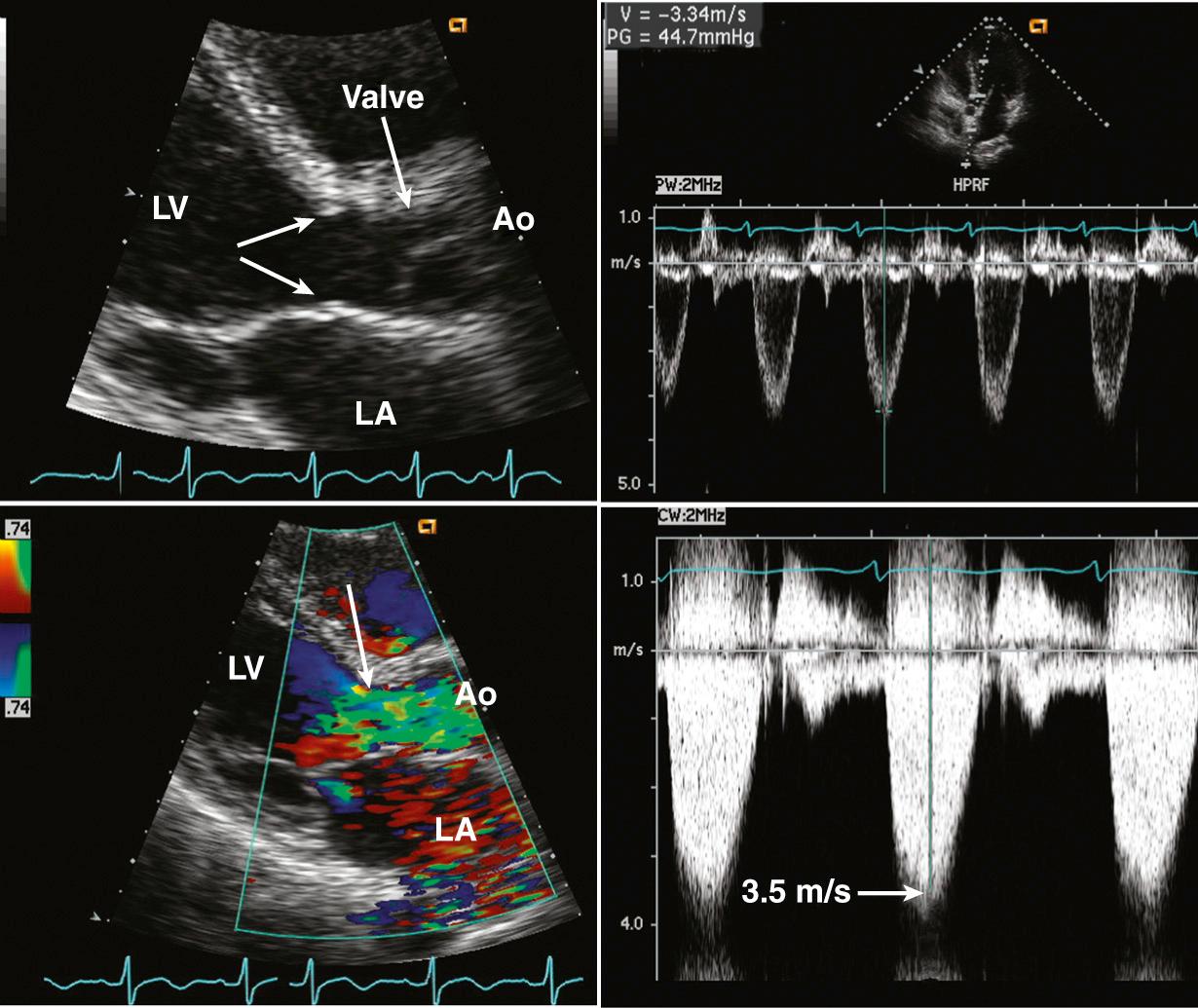
Otherwise, the evaluation of congenital stenosis is similar to the evaluation of acquired stenosis in adults, and the methods described in detail in Chapter 11 are applied in this patient group.
Careful imaging of a congenitally regurgitant valve usually reveals the specific mechanism of regurgitation in that patient. For the atrioventricular valves, particular attention is focused on the number and position of papillary muscles; the chordal attachments (especially aberrant ones); leaflet size, shape, thickness, redundancy, and motion; and annulus size and shape. Malformations include myxomatous changes of the leaflets, abnormal leaflet position (Ebstein anomaly), and abnormal chordal attachments (atrioventricular canal defect) ( Fig. 17.2 ). The semilunar valves may be regurgitant because of great vessel dilation or leaflet fenestration. Three-dimensional (3D) imaging is helpful in the evaluation of leaflet anatomy and the mechanism of regurgitation.
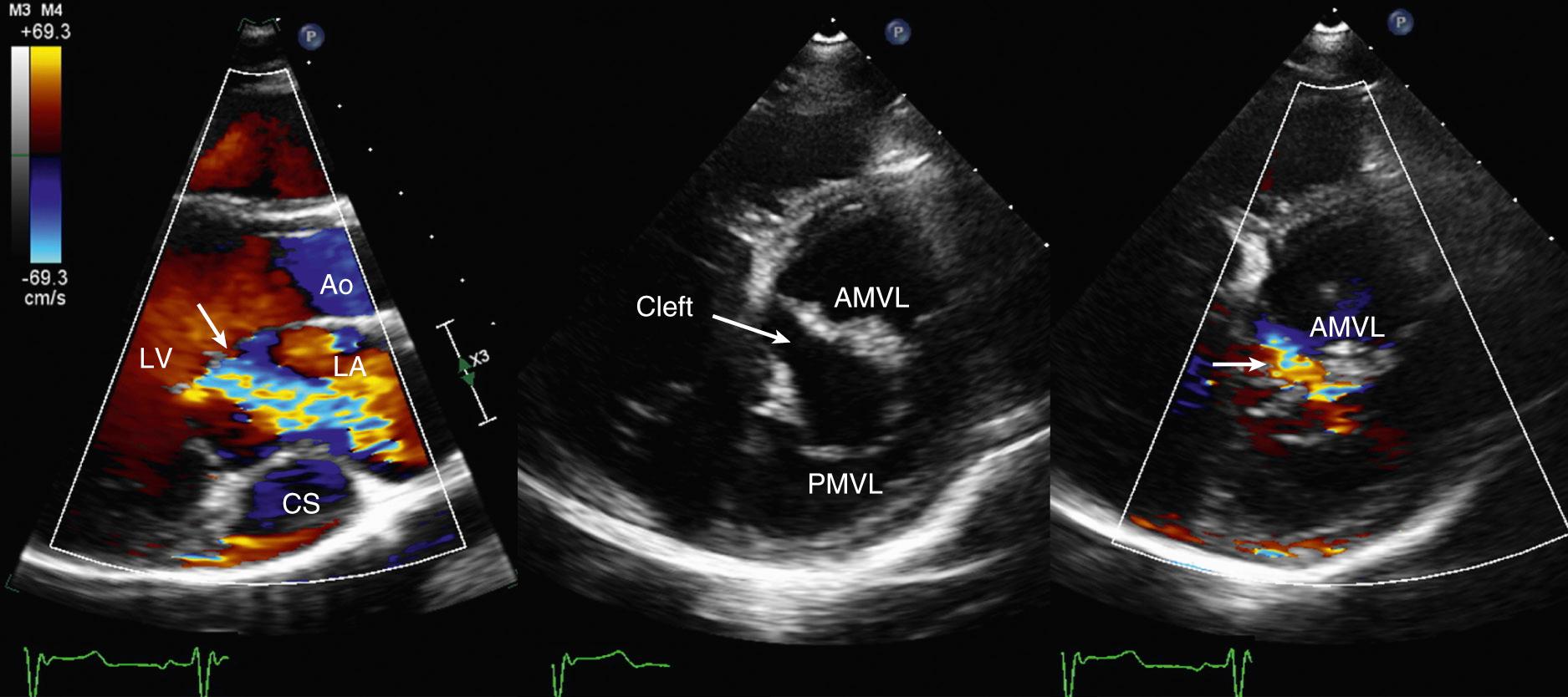
The physiology of congenital regurgitation is no different from that of acquired regurgitation. A flow disturbance occurs in the chamber receiving the regurgitant flow with progressive dilation (and eventual dysfunction) of the volume-overloaded cardiac chambers. The evaluation of congenital regurgitation is similar to the evaluation of acquired regurgitation, as detailed in Chapter 12 .
An abnormal intracardiac communication is characterized by blood flow across the defect, with the direction, timing, and volume of flow determined by the size of the orifice, the pressure gradient across the defect, and the relative resistance to flow of the vascular beds on each side of the defect. If left-sided heart pressures exceed right-sided pressures (pulmonary vascular resistance is low), left-to-right flow across the defect predominates. In addition, small degrees of right-to-left shunting are present briefly during the cardiac cycle because right-sided pressures transiently exceed left-sided pressures.
With conventional pulsed Doppler ultrasound or with color flow imaging, a flow disturbance is found downstream from the defect: on the right side of the interventricular septum for a ventricular septal defect (VSD), in the right atrium (RA) for an atrial septal defect (ASD), and in the PA for a patent ductus arteriosus.
Analogous to a stenotic or regurgitant orifice, the velocity of blood flow through the shunt orifice is related to the pressure gradient across the defect, as stated in the Bernoulli equation. Thus, a small VSD results in a high-velocity systolic flow signal (approximately 5 m/s) because LV systolic pressure greatly exceeds RV systolic pressure (by approximately 100 mmHg) ( Fig. 17.3 ). Conversely, flow across an ASD typically is low in velocity because only a modest left atrial (LA)–to–RA pressure difference is present.
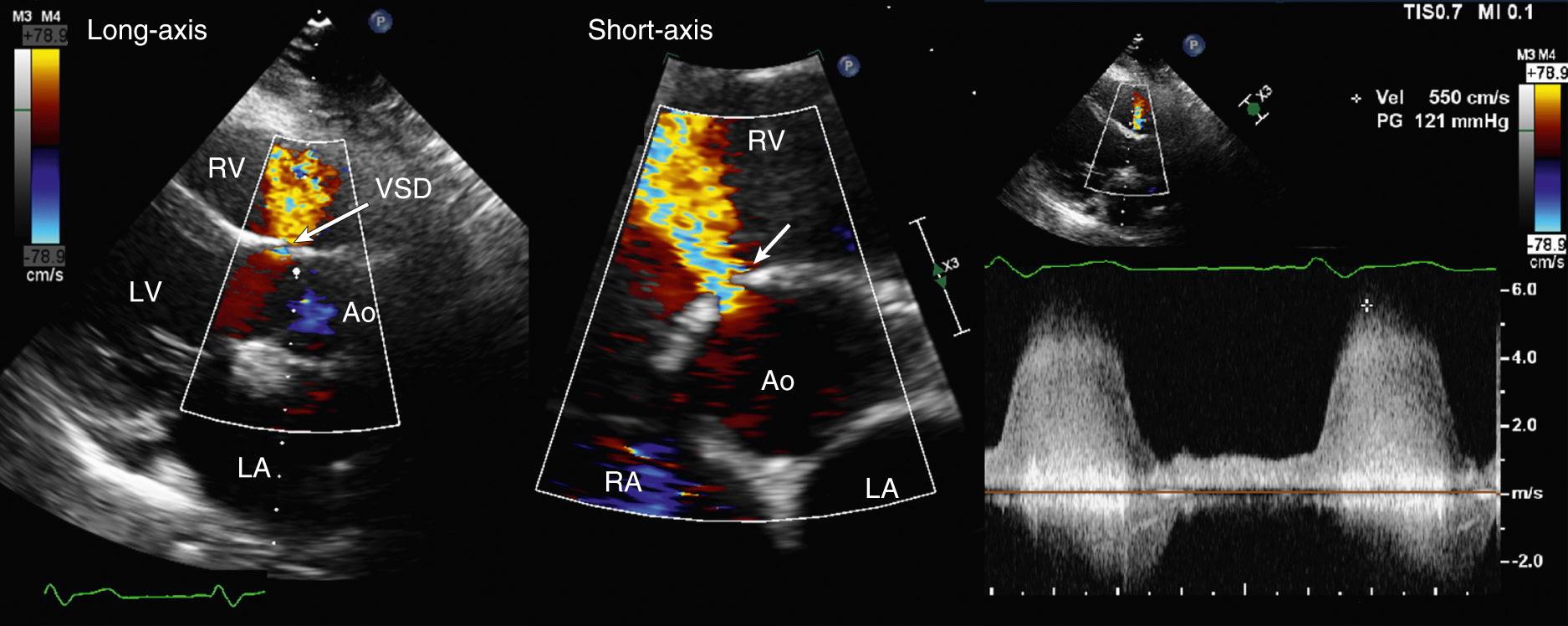
A left-to-right intracardiac shunt imposes chronic volume overload on the receiving chamber(s) with consequent dilation of the affected chamber(s). With an ASD, both RA and RV dilation, along with paradoxical septal motion, are seen. With a patent ductus arteriosus, the volume overload is imposed on the LA and LV. Although it could seem that a VSD would cause RV volume overload, in fact, RV size usually is normal because the LV effectively ejects the shunt flow directly into the PA via the septal defect in systole. Instead, LA and LV dilation is seen because these chambers receive the increased pulmonary blood flow as it returns to the left side of the heart via the pulmonary veins.
The volume of blood flow ( Q ) across an intracardiac shunt—the ratio of pulmonary to systemic blood flow ( Q p : Q s )—is determined by Doppler echo measurements of stroke volume at two intracardiac sites ( Fig. 17.4 ). In the case of an ASD, transpulmonic volume flow ( Q p ) is calculated from the PA cross-sectional area (CSA) and velocity-time integral (VTI), whereas systemic volume flow ( Q s ) is calculated from measurements of LV outflow tract (LVOT) cross-sectional area and velocity-time integral:
so that:
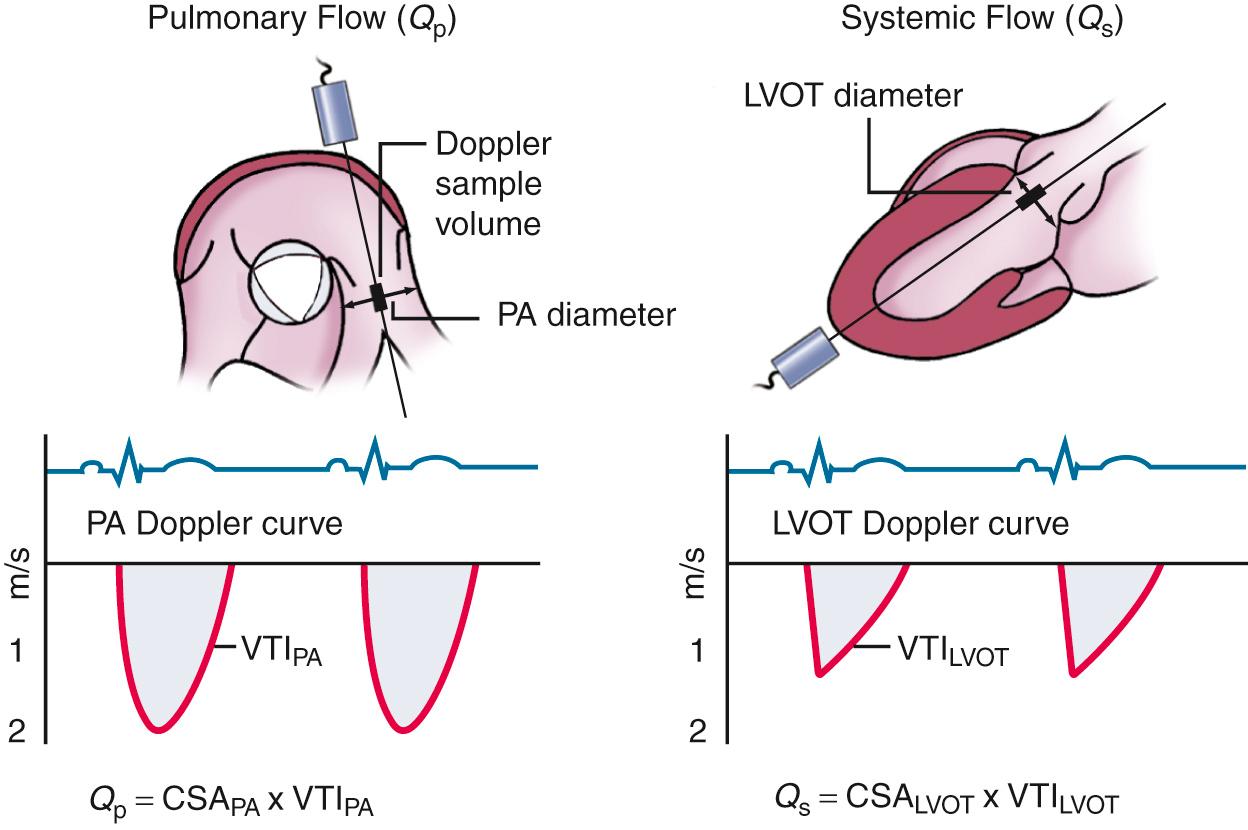
This approach is accurate when two-dimensional (2D) images are of adequate quality for precise diameter measurements (for calculation of a circular cross-sectional area) and when Doppler velocity data are recorded at a parallel intercept angle to flow. Potential errors in estimation of the Q p : Q s ratio are the same as for any Doppler echo stroke volume measurement (see Chapter 6 ).
A 26-year-old woman undergoes echocardiography for symptoms of decreased exercise tolerance. She is found to have an enlarged RA and RV with paradoxical septal motion and the following Doppler data:
| RV outflow velocity | 1.8 m/s |
| Velocity-time integral (VTI RVOT ) | 32 cm |
| Diameter | 2.6 cm |
| LV outflow velocity | 1.1 m/s |
| Velocity-time integral (VTI LVOT ) | 16 cm |
| Diameter | 2.4 cm |
The right heart enlargement suggests that an ASD may be present. The shunt ratio is calculated from the ratio of pulmonary flow ( Q p ), measured in the RV outflow tract (RVOT), and systemic flow ( Q s ), measured in the LV outflow tract (LVOT). At each site, cross-sectional area (CSA) is calculated as the area of a circle:
Flow (stroke volume) at each site then is calculated:
so that
These calculations are consistent with a significant shunt that is likely to cause progressive right heart dysfunction unless the defect is closed.
With significant left-to-right shunting, pulmonary pressures become elevated, and irreversible pulmonary hypertension develops over time. When pulmonary vascular resistance equals or exceeds systemic vascular resistance, the direction of shunt flow reverses, resulting in decreased systemic oxygen saturation and cyanosis. Irreversible pulmonary hypertension with equalization of pulmonary and systemic pressures due to an intracardiac shunt is known as Eisenmenger physiology . This can occur in infancy, particularly with a large VSD, but it also can occur later in life when the pulmonary-to-systemic shunt ratio chronically exceeds about 2 : 1.
Echocardiographic diagnosis is more difficult when abnormal connections exist between the atrium and the ventricles, between the ventricles and great vessels, or both. In adults, poor acoustic access further compromises the examination; but with a systematic approach, a correct anatomic evaluation usually is possible.
Because the position of the heart in the chest often is abnormal, the echocardiographer cannot rely on the intrathoracic position of the chambers for correct identification of cardiac anatomy. Dextroposition is a rightward shift in the cardiac position with otherwise normal anatomy; for example, due to decreased right lung volume or severe scoliosis. Acoustic windows are shifted rightward, but image planes are similar to normal. With dextroversion , the cardiac apex points to the right, but the right and left heart chambers are otherwise normally related. Long-axis views are obtained with the image plane aligned from the left shoulder to the right hip, and the apical window is mid-line or right of the sternum. In contrast, with mirror image dextrocardia , cardiac anatomy is a mirror image of normal (the right-sided chambers are left of the left-sided chambers), and the heart is located in the right hemithorax with the apex in the right mid-clavicular line. Thus, acoustic windows are on the right chest with image planes mirror images of normal. The term situs inversus refers to right-to-left reversal of thoracic and abdominal viscera.
Atrial situs refers to the position of the RA and LA in the chest. The inferior vena cava nearly always drains into the RA, thereby allowing correct identification of this chamber by imaging the inferior vena cava from a subcostal approach and following it into the RA. Thus, the subcostal window often is a useful starting point for the examination of a patient with complex congenital heart disease. The LA, then, is the “other” atrial chamber because although the pulmonary veins normally drain into the LA, this is not always the case (e.g., partial or total anomalous pulmonary venous return).
The anatomic RV and LV are distinguished from each other by several features ( Fig. 17.5 ). The anatomic RV has:
Prominent trabeculation
A moderator band
An infundibular region
A more apical atrioventricular annulus than the LV
A tricuspid valve
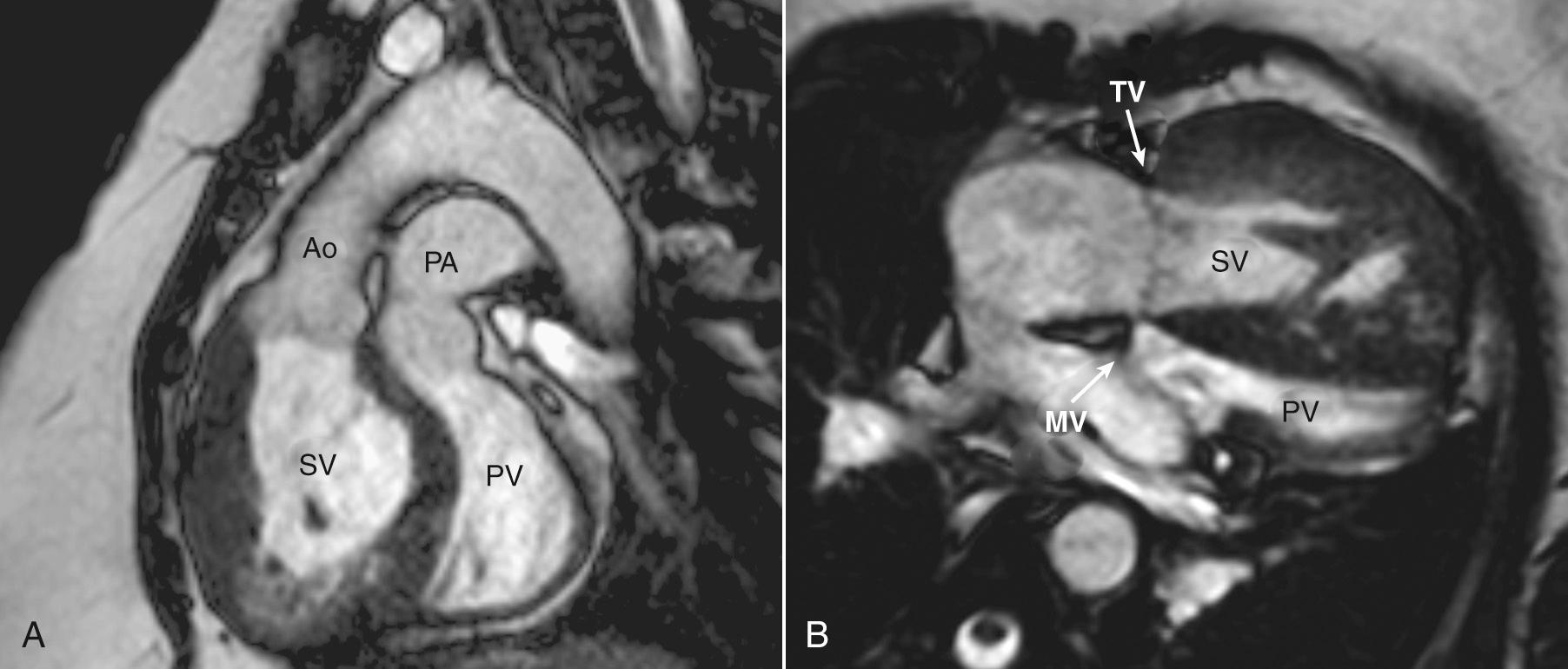
Fibrous continuity of the anterior mitral valve leaflet and the aortic valve occurs only with a normally related LV and aortic root. When the anatomic RV connects to the aortic root, a band of myocardium is seen between the base of the atrioventricular valve leaflet and the great vessel. When abnormal connections of the anatomic ventricles are present, the ventricle pumping blood to the pulmonary bed is called the subpulmonic ventricle and the ventricle pumping blood into the aorta is called the systemic ventricle.
The atrioventricular valves develop with the appropriate anatomic ventricle, so identification of the mitral valve is another feature that differentiates the LV from the RV. Caution is needed if a cleft anterior mitral valve leaflet is present because it may superficially resemble the tricuspid valve. In addition to the number of atrioventricular valve leaflets, the relative positions of the atrioventricular valve annuli are helpful because the tricuspid valve annulus lies slightly closer to the apex than the mitral valve annulus. Note that ventricular size, shape, and/or wall thickness do not distinguish the two ventricles because congenital lesions can result in dilation and hypertrophy of either chamber.
After identifying the atrium and ventricles, attention is directed toward the great vessels. The aortic root is best identified by following the vessel downstream to image the arch and head and neck vessels. Visualization of the origins of the coronary arteries is helpful, but anomalous origin of the coronary arteries from the PA must be considered. The PA is identified by its bifurcation into right and left branches.
The position of the great vessels within the thorax and relative to one another often is altered in congenital disease. Normally, the PA lies anterior and slightly medial to the aortic root at its origin and then courses posteriorly and laterally, with the right PA lying posterior to the ascending aorta. The aortic annulus normally lies posterior to the RV outflow tract, with the aortic root extending medially and anteriorly before turning posterolaterally to form the aortic arch. The normal relationship of the aortic and pulmonic valve planes is approximately perpendicular to each other, with the pulmonary valve slightly more superior within the chest than the aortic valve. With transpositions of the great vessels, these relationships are altered, so the semilunar valves lie in the same tomographic plane, and the aorta and the PA lie parallel to each other instead of in their normal “crisscross” positions. If the aorta is anterior and to the left, L (for levo) transposition is present. An anterior and medial (rightward) aorta is termed D (for dextro) transposition.
Most patients with abnormal connections between the cardiac chambers and great vessels have associated abnormalities that require echocardiographic evaluation. These include intracardiac shunts, stenotic and regurgitant lesions, pulmonary hypertension, and ventricular dysfunction. The echocardiographic examination in these patients is facilitated by:
Knowledge of the patient's clinical history, including previous surgical procedures and diagnostic tests
Formulation of specific clinical questions to be answered by the echocardiographic examination
During the examination, the physician and the sonographer work together to identify:
Cardiac chambers, great vessels, and their connections
Associated defects
Physiologic consequences of each lesion
Clinical questions that remain unanswered at the end of examination
In addition, the echocardiographer should suggest other appropriate imaging modalities to address any areas of uncertainty.
Although a congenital bicuspid aortic valve is the most common type of congenital heart disease (reported to occur in 1% to 2% of the general population), the bicuspid valve often is functionally normal until about age 50 years or later, when superimposed fibrocalcific changes lead to aortic valve stenosis. Significant regurgitation of a congenital bicuspid valve occurs somewhat less commonly but manifests in young adulthood with a diastolic murmur and symptoms of exercise intolerance.
The presentation of significant LV outflow obstruction in a young adult should prompt consideration of abnormalities other than a bicuspid valve, specifically a unicuspid aortic valve, a subaortic membrane, or hypertrophic cardiomyopathy. A unicuspid aortic valve appears as a thickened, deformed valve with systolic bowing of the valve on ultrasound imaging. A high parasternal short-axis view shows the eccentric unicuspid opening in systole. 3D transthoracic echocardiography (TTE) or transesophageal echocardiography (TEE) further defines valve anatomy. Doppler echocardiography allows measurement of the transvalvular gradient and valve area as for any type of aortic valve stenosis. Restenosis of the aortic valve in patients who previously underwent surgical valvotomy in childhood or adolescence is common. Restenosis occurs in up to 40% of patients a mean of 13 years after open surgical valvotomy.
Congenital subaortic obstruction ranges anatomically from a muscular ridge to a thin membrane. Although typically located 1 to 1.5 cm apically from the aortic valve plane, the membrane sometimes is located immediately adjacent to the aortic valve. In either case, a subaortic membrane is difficult to see in adults because of poor acoustic access. The possibility of a subaortic membrane should be considered when high-velocity flow is recorded in the LV outflow tract, but the aortic valve leaflets appear normal. TEE allows direct imaging of the subaortic membrane, especially if multiple image planes or 3D images are used to identify this thin structure. Conventional pulsed Doppler, high-pulse repetition frequency Doppler, and color flow imaging are helpful from either TTE or TEE approaches in demonstrating that, in contrast to valvular aortic stenosis, the increase in antegrade velocity and poststenotic flow disturbance occurs on the LV side of the aortic valve and indicates that subaortic obstruction is present. Coexisting aortic regurgitation occurs because of chronic exposure of the aortic valve leaflets to the high-velocity subaortic flow, resulting in a “jet lesion” on the aortic valve, or (rarely) because of fibrous attachments from the subaortic membrane to the aortic valve leaflets.
The level of RV outflow obstruction ranges from subvalvular (in the muscular outflow tract), valvular to supravalvular (either in the main PA or its major branches). Pulmonic stenosis sometimes occurs as an isolated anomaly but more often is part of a complex of defects (e.g., tetralogy of Fallot) or is associated with other abnormalities (e.g., corrected transposition). The level of outflow obstruction is determined using pulsed Doppler and color flow to identify the anatomic site at which the flow velocity increases and the poststenotic flow disturbance appears. The obstruction itself is seen on 2D or 3D imaging as a muscular subpulmonic ridge; as deformed, doming pulmonic valve leaflets; or as a narrowing in the PA. If significant obstruction is present, compensatory RV hypertrophy typically is seen.
The degree of obstruction is measured by Doppler ultrasound by using the Bernoulli equation ( Fig. 17.6 ), with the proviso that only an estimate of the total obstruction is possible if serial stenoses are present. Note that in the presence of pulmonic stenosis, the tricuspid regurgitant jet velocity remains an accurate reflection of the RV to RA systolic pressure difference but no longer indicates PA systolic pressure. Instead, PA systolic pressure (PAP) is estimated by calculating the:
RV systolic pressure (RVSP) based on the tricuspid regurgitant jet velocity ( V TR ) and RA pressure (RAP) estimated from the inferior vena cava size and respiratory variation:
RV-to-PA gradient (Δ P RV-PA) from the pulmonic stenosis jet velocity ( V PS ):
PA systolic pressure (PAP) by subtracting the transpulmonic gradient from the estimated RV systolic pressure:
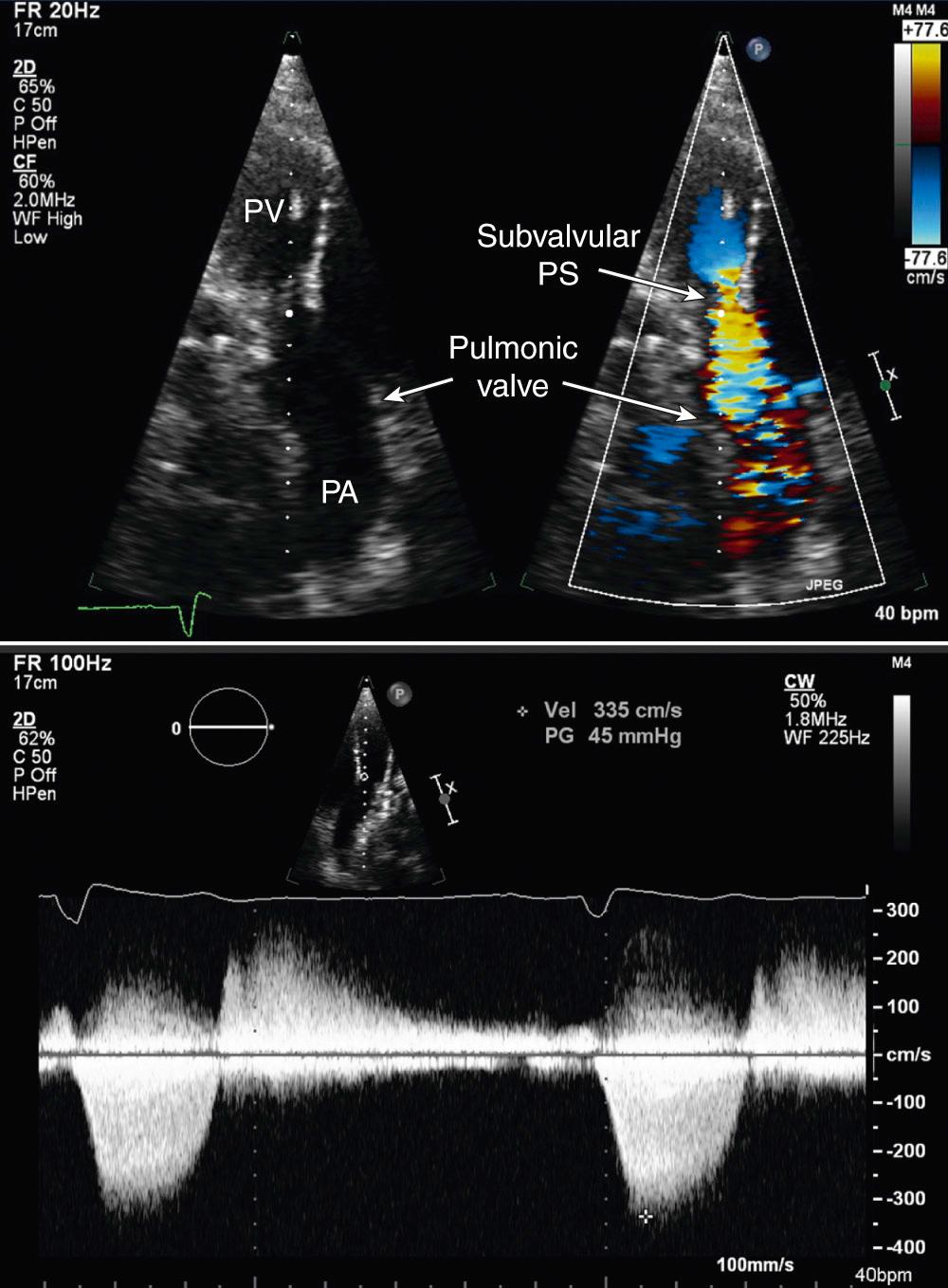
The end-diastolic velocity in the pulmonic regurgitation jet also provides useful data on PA pressures because it reflects the diastolic pressure difference between the PA and the RV (high in patients with pulmonary hypertension, low in patients with pulmonic stenosis, and normal PA diastolic pressures).
A 24-year-old with a history of a cardiac murmur has an echocardiogram which shows:
| RV outflow velocity | 1.6 m/s |
| PA velocity | 3.1 m/s |
| Tricuspid regurgitant jet | 3.4 m/s |
| Estimated RA pressure | 5 mmHg (small inferior vena cava with normal respiratory variation) |
Because the RV outflow velocity is elevated, the maximum pulmonic valve gradient should be calculated using the proximal velocity (V 2 prox ) in the Bernoulli equation:
If the proximal velocity is not included, the gradient would be overestimated at 38 mmHg.
Estimated pulmonary systolic pressure (PAP) is calculated by subtracting the pulmonic valve gradient from the estimated RV pressure because pulmonic stenosis is present:
Thus, estimated PA systolic pressure is normal even though the tricuspid regurgitant jet indicates an RV systolic pressure of 51 mmHg.
A congenital narrowing in the proximal descending thoracic aorta most often is located just upstream from the entry site of the ductus arteriosus. Less often, postductal coarctation is seen. The coarctation usually is relatively discreet, with involvement of only a short segment of the aorta, but sometimes is a long, tubular narrowing. Imaging the coarctation site is difficult from a TTE suprasternal notch window in adults. Even in normal individuals, the descending thoracic aorta appears to taper because the tomographic view cuts the aorta obliquely as it leaves the image plane. Restenosis manifests at variable ages in adults with previous surgical coarctation repair, depending on the specific surgical procedure and the patient's age at the time of repair. For both operated and unoperated coarctations, TEE imaging with a long-axis view of the descending aorta can be helpful, although CT and CMR imaging now are the standard clinical approaches.
Doppler examination shows an increased velocity across the coarctation and, if the obstruction is severe, persistent antegrade flow into diastole ( Fig. 17.7 ) sometimes called diastolic run-off. If the velocity proximal to the coarctation is elevated, the proximal velocity should be included in the Bernoulli equation for pressure gradient estimation. The jet direction in an unoperated coarctation is very eccentric, so it rarely is possible to achieve a parallel alignment between the ultrasound beam and the jet direction, a situation that leads to underestimation of the severity of the obstruction. In restenosis of a previously operated coarctation, the jet orientation tends to be more symmetric, and a parallel intercept angle with correct estimation of the pressure gradient is more likely. In either case, other clinical methods for assessing the severity of the coarctation are available (e.g., upper versus lower extremity blood pressure).
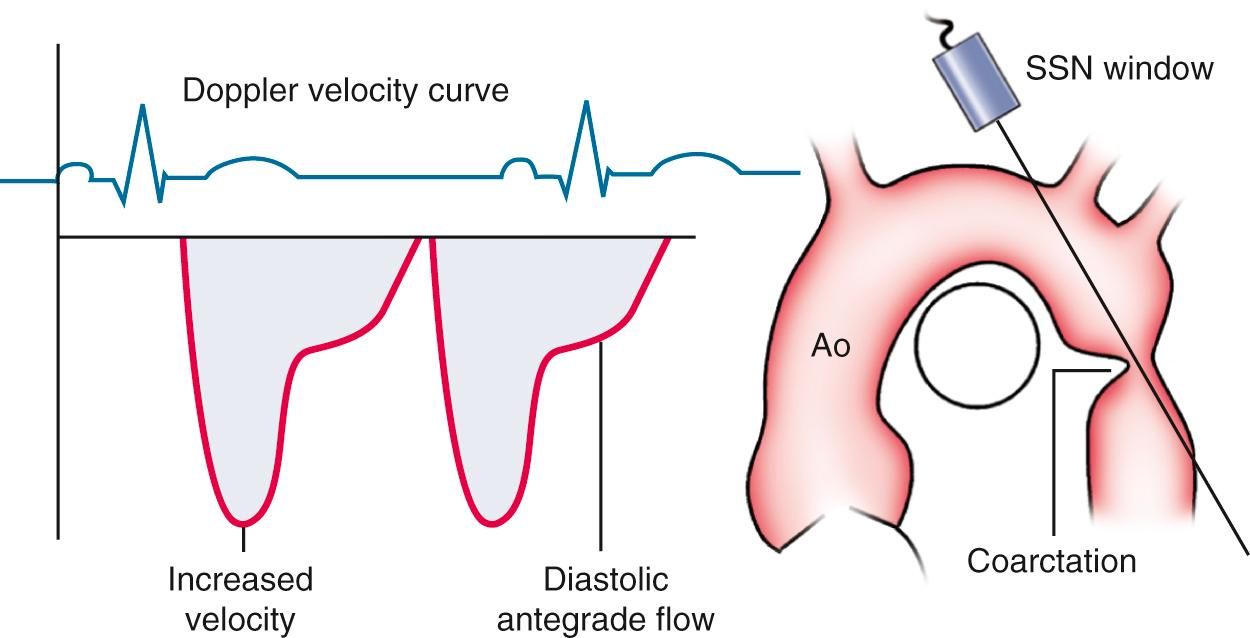
A congenital aneurysm of the aortic sinuses of Valsalva appears as a thin, dilated area that projects into adjacent cardiac structures, often with a fistulous communication, depending on which sinus is involved. On echocardiographic imaging, a congenital aneurysm often has a “wind sock” appearance with a long, convoluted, mobile sac of tissue extending from the aortic sinus into adjacent cardiac structures (see Fig. 16.3 ). This appearance contrasts with the more symmetric dilation seen in aneurysms due to endocarditis. An aneurysm of the noncoronary sinus projects into the RA, the left coronary cusp into the LA, and the right coronary cusp into the RV outflow tract. If a fistula is present, pulsed and color Doppler flow images demonstrate a left-to-right shunt with a flow disturbance in the receiving chamber. Continuous-wave (CW) Doppler shows a high-velocity systolic and diastolic flow signal.
A coronary arteriovenous fistula is a rare congenital anomaly that manifests in young adults as a continuous murmur. The abnormal communication typically arises from a coronary artery and empties into the coronary sinus or RA. A coronary arteriovenous fistula is recognized echocardiographically as an abnormal area of dilation with diastolic or continuous flow in addition to a flow disturbance at the site of entry into the cardiac chamber ( Fig. 17.8 ).
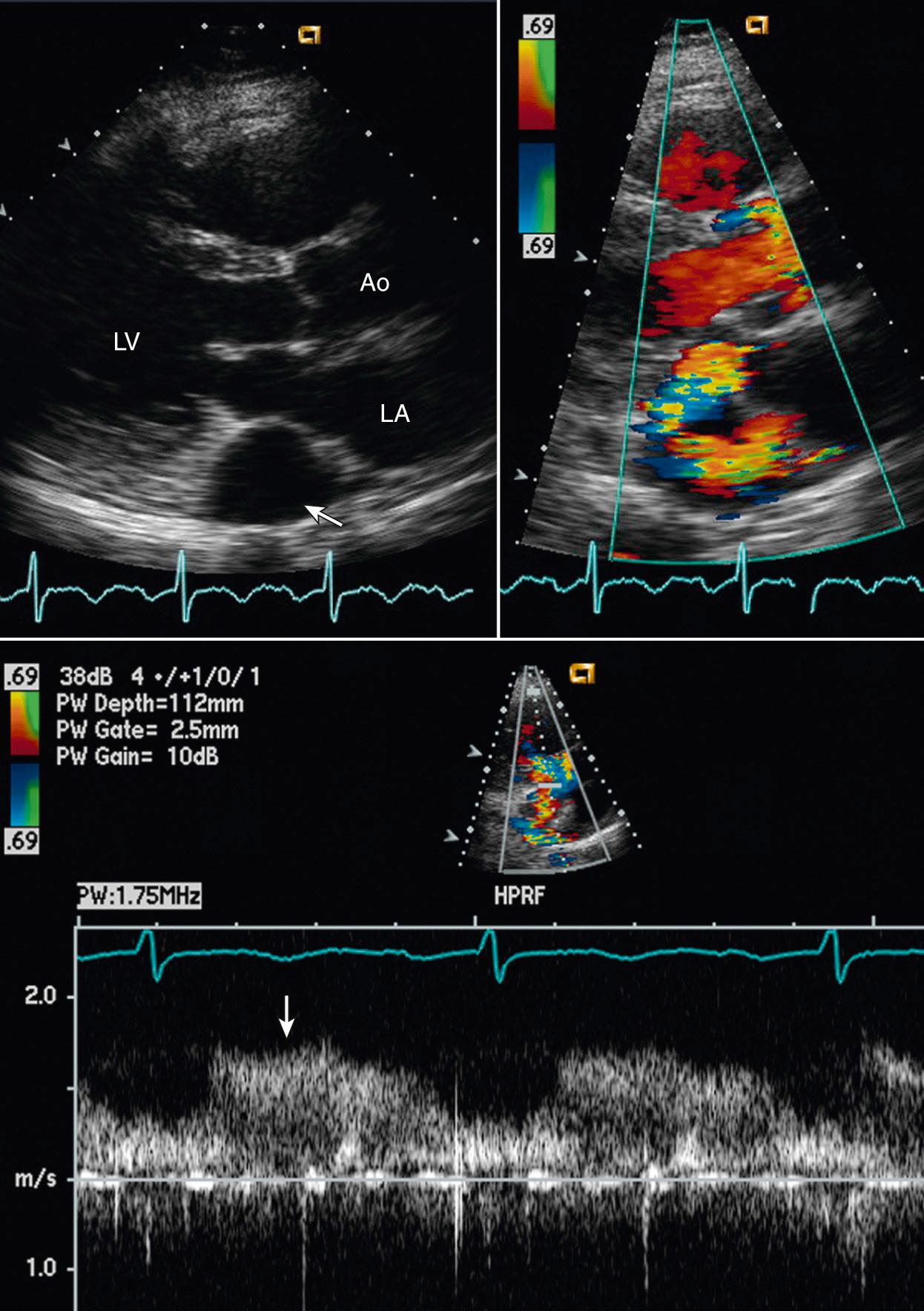
Become a Clinical Tree membership for Full access and enjoy Unlimited articles
If you are a member. Log in here